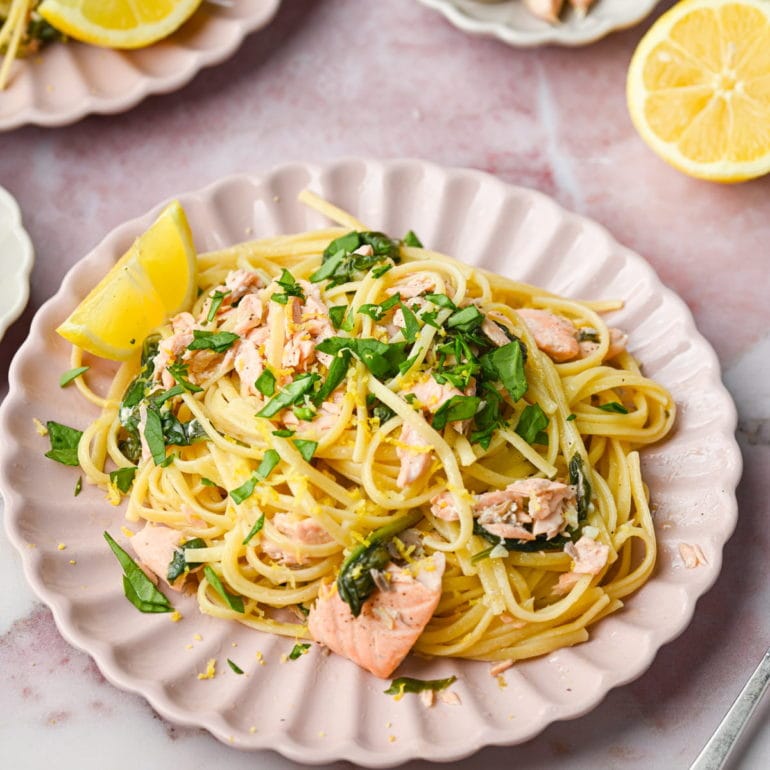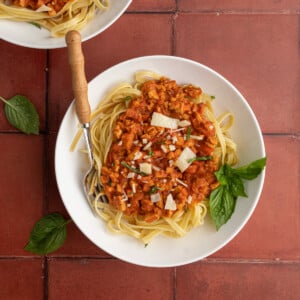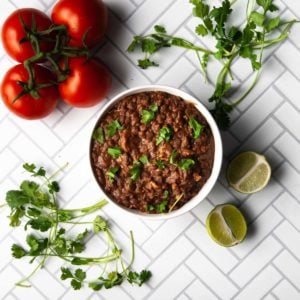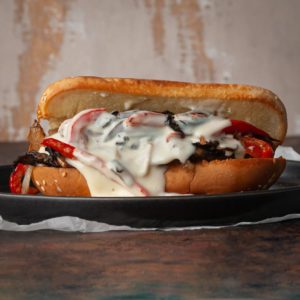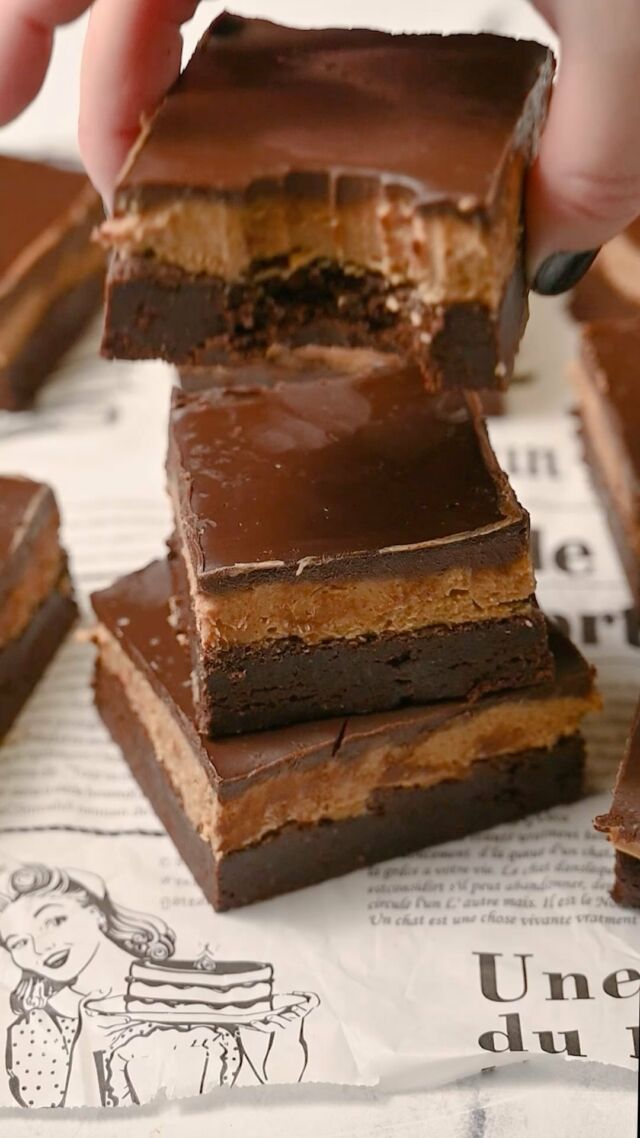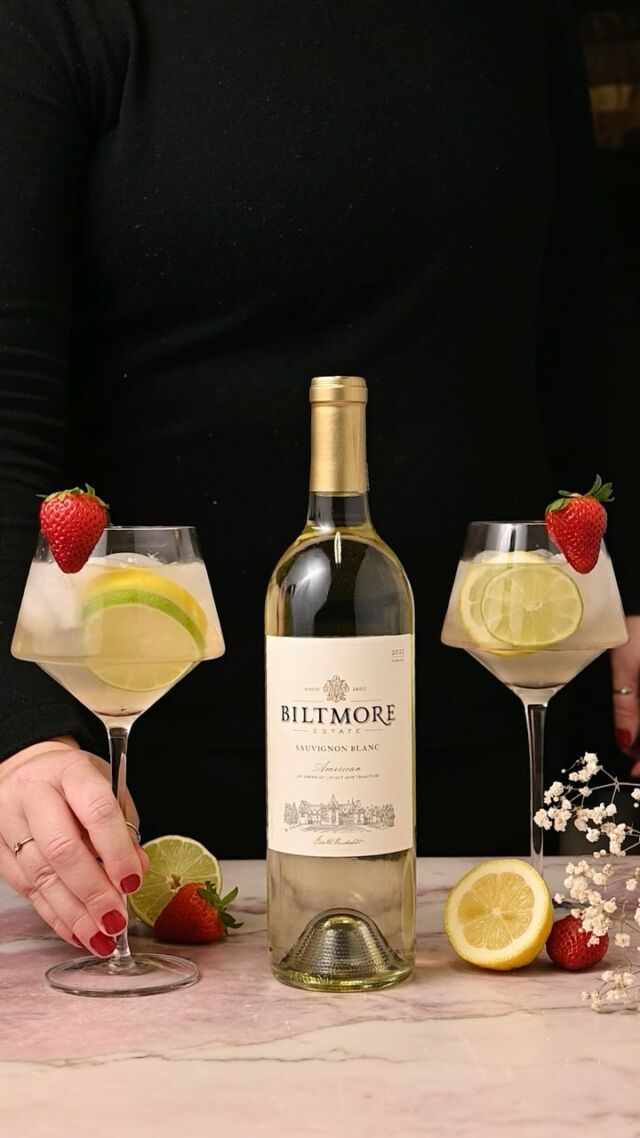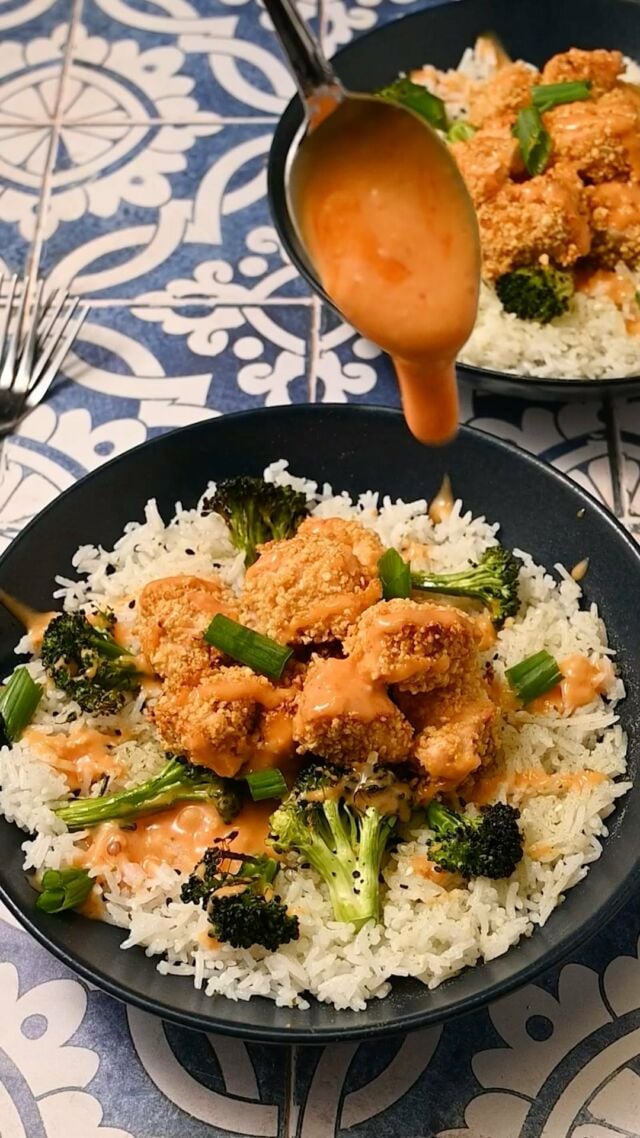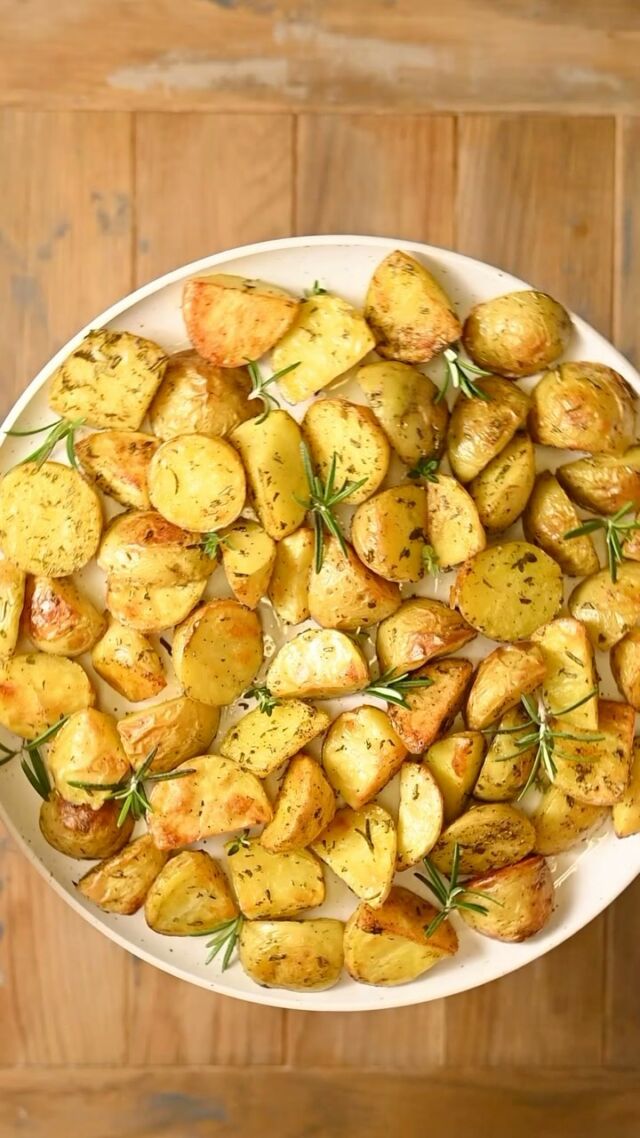Looking for a filling and nutrient-filled dinner to whip up in 30 minutes? This quick 30-minute Salmon Spinach Pasta features with zesty white wine sauce made with butter —no cream needed.
Plus, this recipe uses just 10 ingredients, making it perfect for those days when you want a flavorful and satisfying pasta dinner with salmon that’s simple to make!
The buttery, zesty, white wine sauce is the perfect accompaniment to the pasta and spinach, and really allows the salmon to shine! Plus, the ease of this recipe and how quickly it comes together will make this salmon dinner idea a part of your weekly rotation.
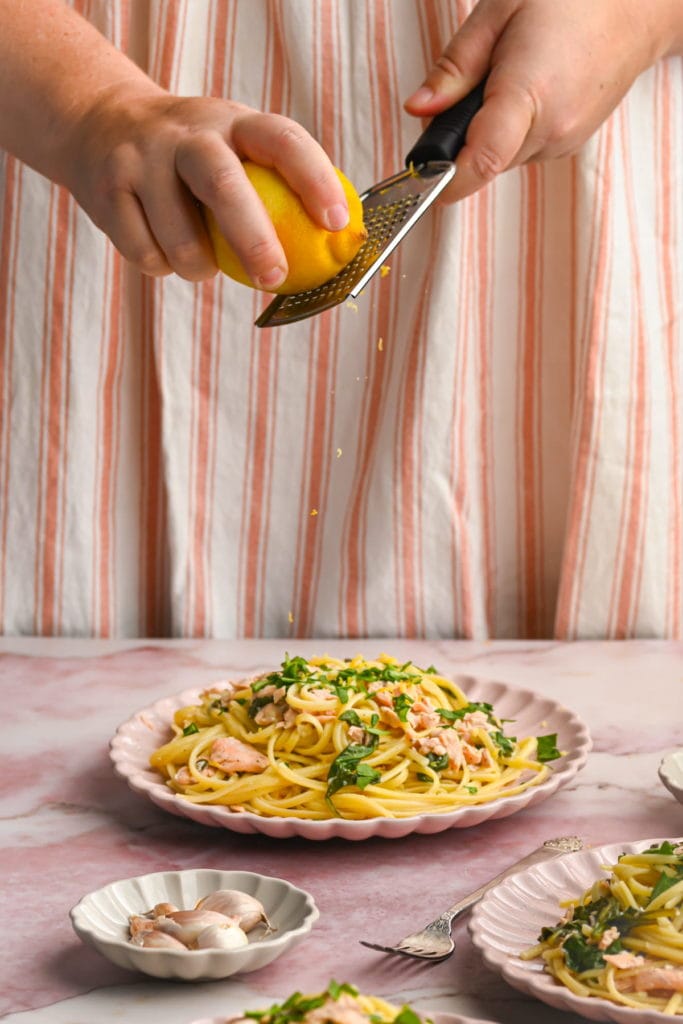
As an environmental scientist and busy mom, I often rely on pasta as a staple in my house for a comforting meal with an environmentally conscious base.
Green tip: When it comes to choosing a starch with a lower carbon footprint, pasta is a great option! Manufacturing is a relatively less intensive process (less energy used), and its long shelf-life means you’re less likely to waste it!
Salmon Spinach Pasta Ingredients
Here’s everything you need:
- Salmon. You can buy skinless or remove the skin before getting started. 1 pound should be plenty to serve four and is a great ratio for a full box of pasta. Fresh or frozen work here, just allow frozen salmon to thaw before using it.
- Salt and pepper. To amp up the flavor. You’ll season the salmon with it, then add the rest to your white wine sauce.
- Lemon. You’ll need the zest and juice of one large lemon for this recipe.
- Olive oil. To cook the salmon and garlic in.
- Garlic. To flavor your white wine sauce.
- Spinach. For some freshness and nutrients. I like to use fresh baby spinach in this recipe.
- White wine. Pinot Grigio or Sauvignon Blanc is preferred, but any white wine that’s on the dryer side will work.
- Unsalted butter. To allow you to have control over the salt content in your sauce.
- Long pasta. Like linguine, fettuccine, spaghetti, angel hair, bucatini, tagliatelle, pappardelle, or vermicelli.
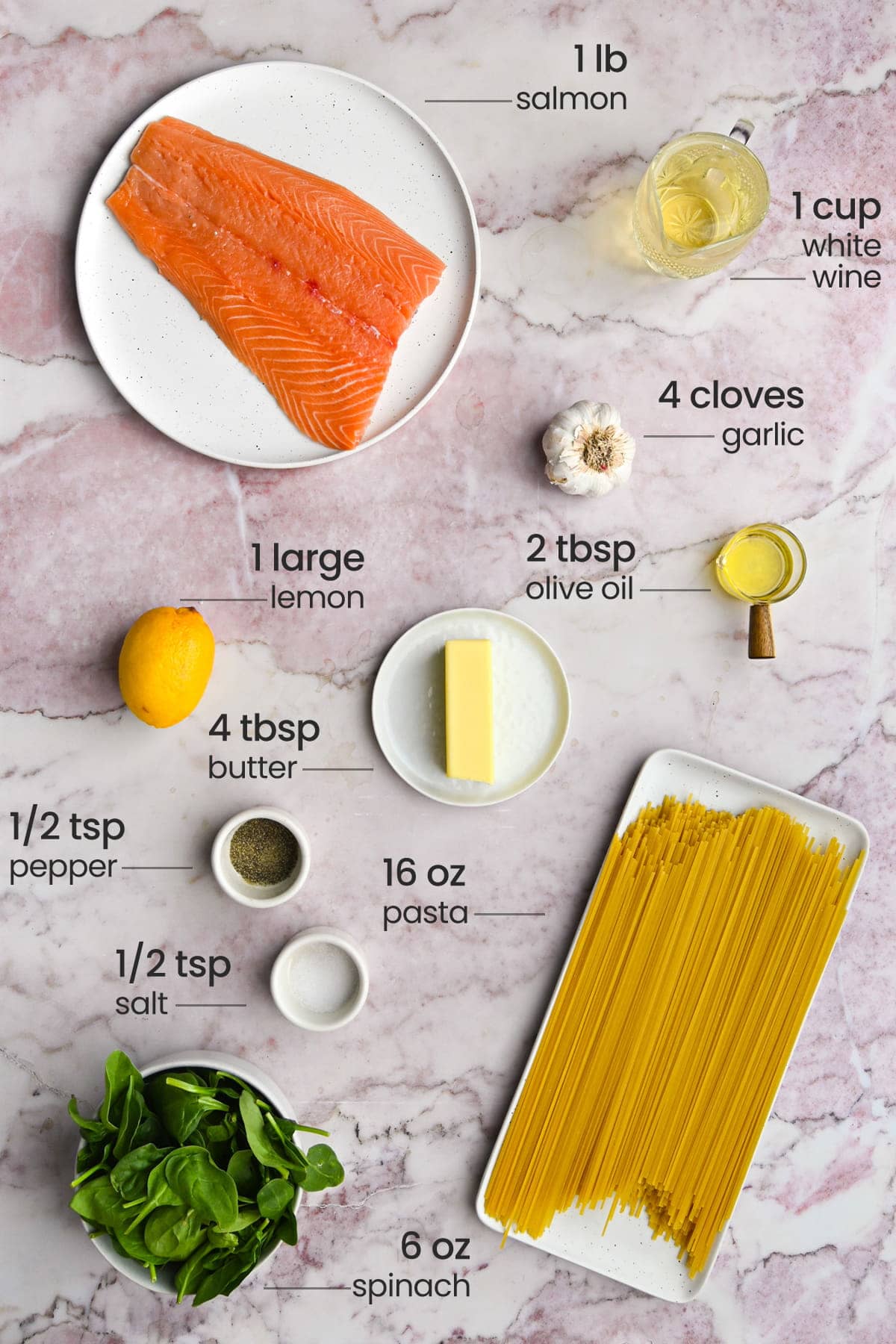
Sourcing Sustainable Salmon
If not done correctly, salmon farming can pose a risk to our environment for several reasons. This includes, but is not limited to, the antibiotics used in salmon farms that can then leach into the surrounding environment and the depletion of other wild fish harvested to feed the salmon.
However, wild-caught salmon poses other risks, including overfishing and bycatch. Plus, there are often issues with availability and access to wild-caught salmon.
So where does that leave us when it comes to sourcing salmon sustainably?
We have two great choices: sustainably farmed salmon, or wild-caught Alaskan salmon.
Green tip: Look for Marine Stewardship Council and Friend of the Sea labels on your fish to ensure they were harvested sustainably.
Salmon Spinach Pasta No Cream Tips and Tricks
Prep Your Salmon First
Before we get cookin’, this salmon and pasta dish, the first step is to prep your salmon. Whether you’re using fresh or frozen, to get a crispy exterior on your salmon, it’s best to pat it dry before seasoning it.
I recommend using this salmon drying technique in a lot of my fish dishes, including this Sheet Pan Salmon and Almond-Crusted Salmon!
Green tip: Paper products contribute to deforestation. Consider these bamboo paper towels! Bamboo naturally regenerates every few months, whereas trees cannot regrow once harvested.
Place your fish filets in between two paper towels and press down to pat dry. Drying the fish will ensure your seasoning sticks, and will avoid extra hot oil splatter from additional water on the fish.
Once your salmon is dry, sprinkle a pinch of salt and pepper on each side of your salmon. Set the rest of the salt and pepper aside to add to your pasta with fish later on.
Squeeze just a touch of lemon juice onto the salmon as well, conserving the rest of the lemon juice and the zest to add later.
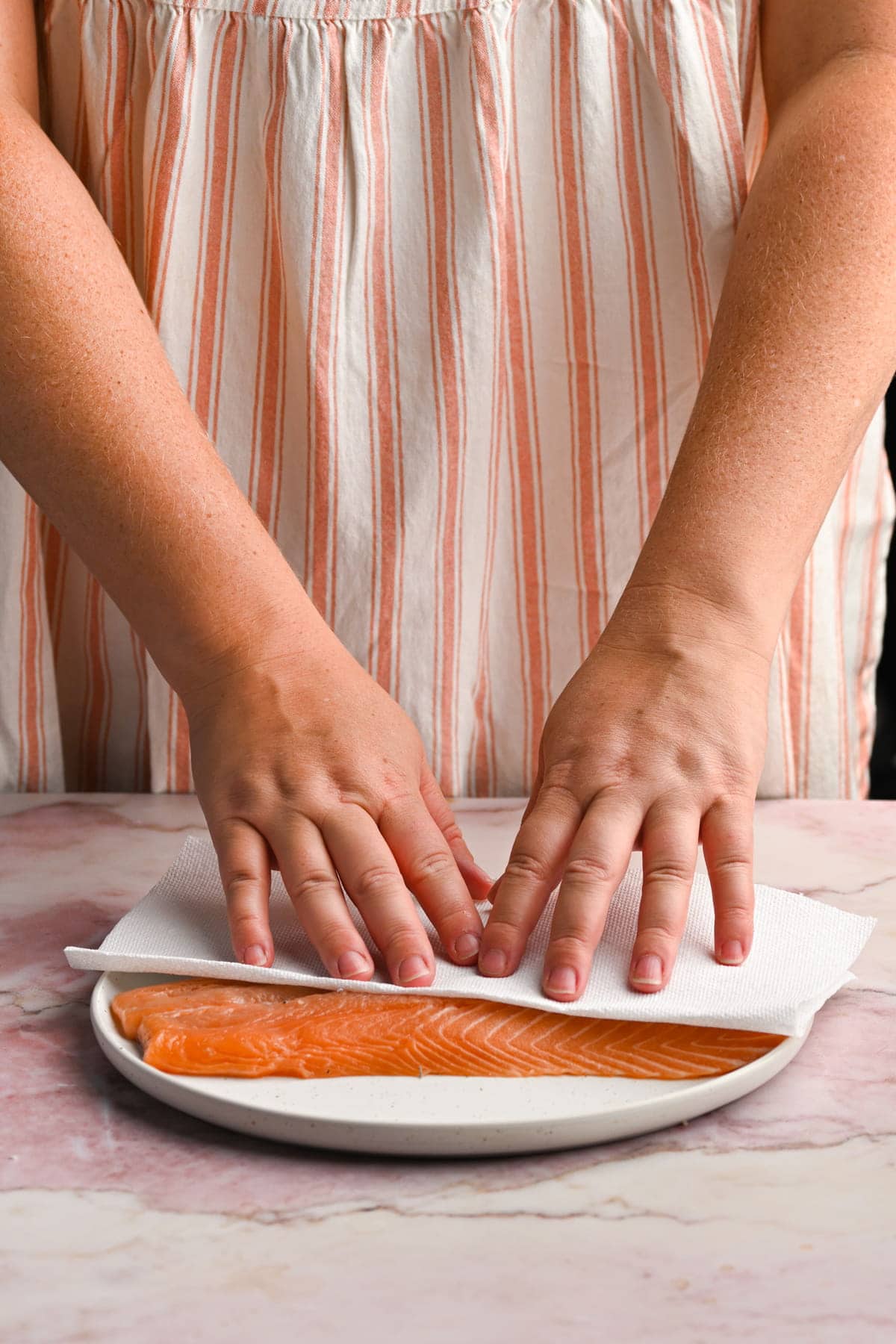
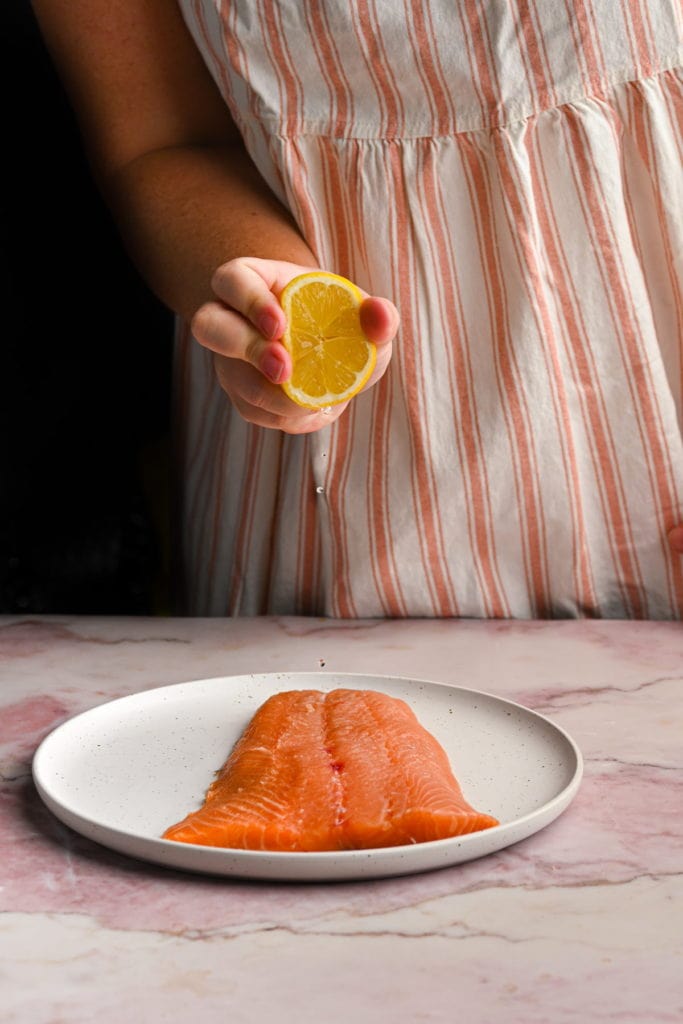
Sear Your Salmon
To cook up your fish for this salmon dinner bowl, you’ll want to start by getting the oil hot.
Add your oil to your saucepan or shallow pot over medium heat and allow the oil to heat up. Then, carefully place your salmon into the hot oil and sear for about 2 minutes on each side.
At this point, you’ll get a little crispiness on the outside of the salmon, which will give it a delicious texture. It’s okay if the salmon is not cooked fully through, as it will have plenty of time to finish cooking later.
Remove the salmon and set it aside, to add back to your pot later to poach in the white wine sauce.
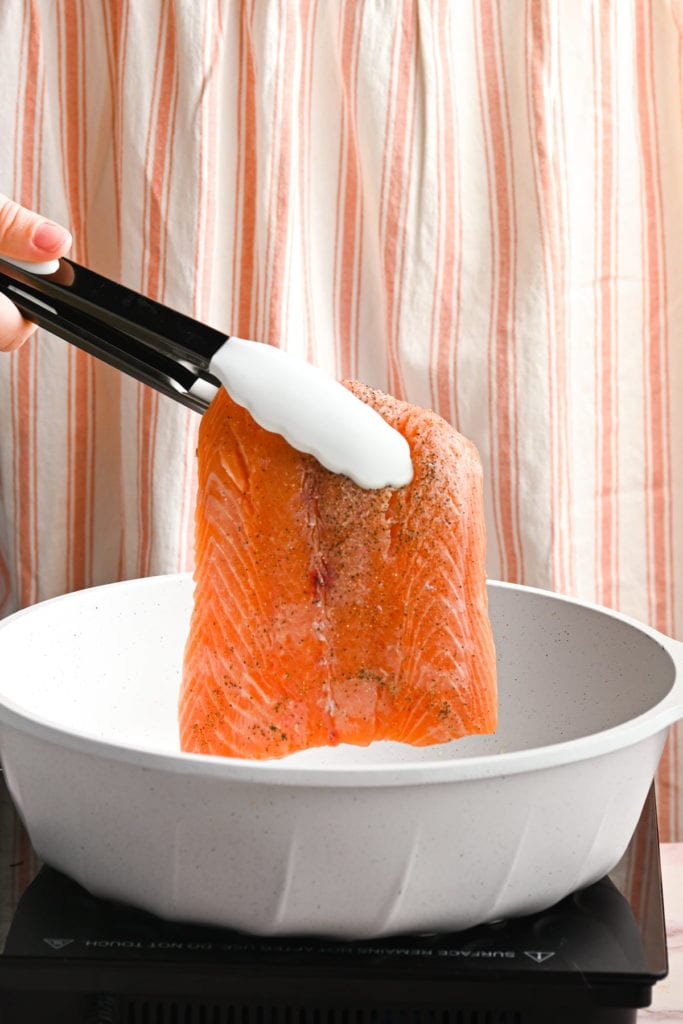
Toast Your Garlic
Next, add your minced garlic to the hot, salmon-flavored oil to toast. Keeping your heat source on medium-high, cook the garlic until its fragrant, just about 2 minutes, before adding more ingredients.
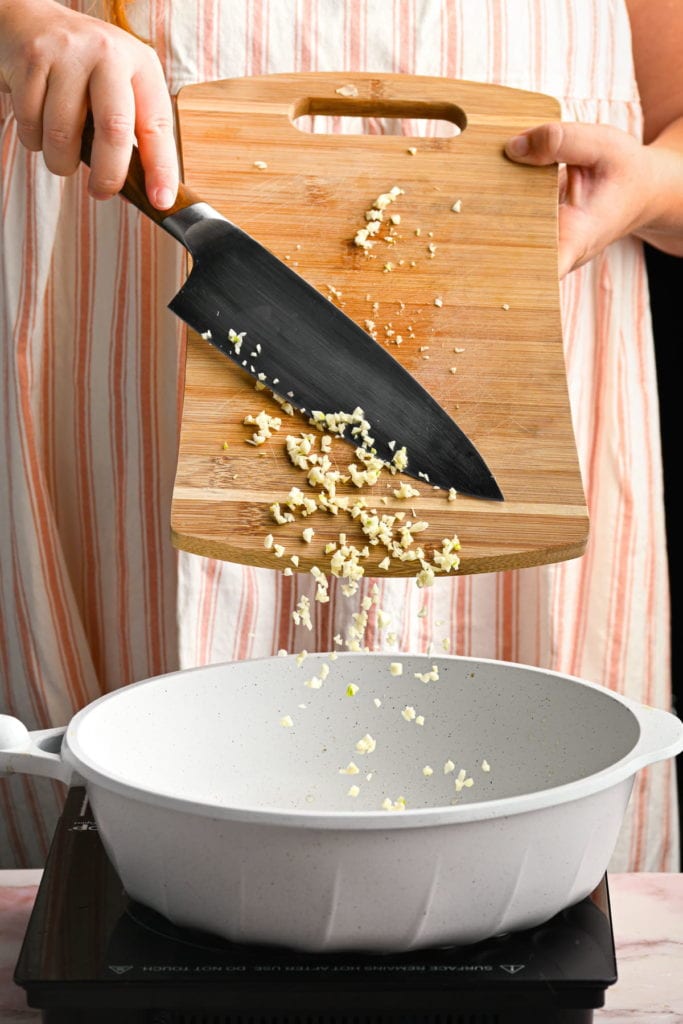
Wilt Your Spinach
Next, add your spinach to the garlic and oil to release some of the liquid from the spinach.
Give it a couple of stirs, and watch as your spinach starts to shrink. Once you’ve cooked off the liquid for about 2 minutes, you can add the rest of your ingredients back to your pot.
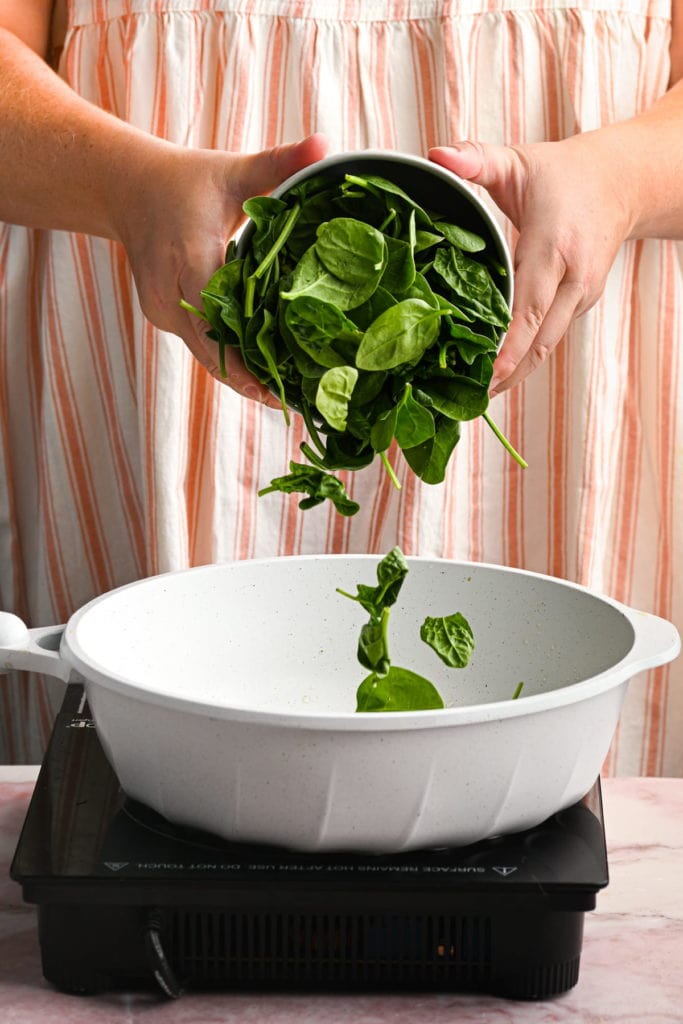
Add Your Salmon Back to the Pot
Use your tongs, a fork, or a knife to break the salmon into bite-size pieces. Again, don’t worry if it’s not cooked all the way through.
The broken-up salmon will poach in the sauce, giving both the sauce and the salmon a deeper flavor.
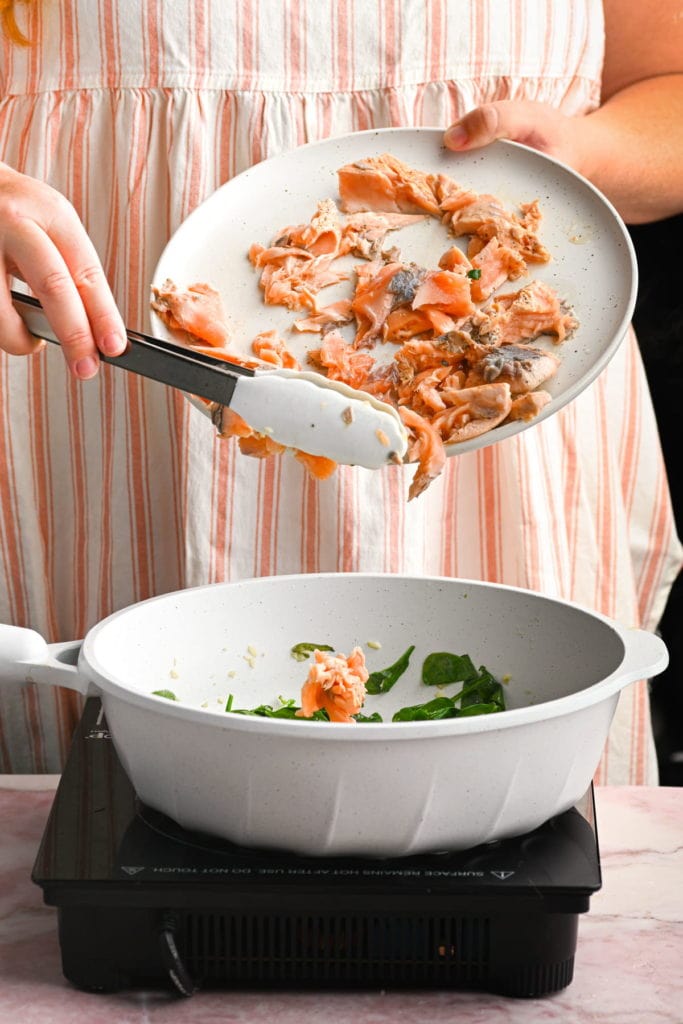
Develop Your Sauce
Add your white wine, butter, lemon zest, and the remaining juice of the lemon to your pot.
Pro tip: Save your top-shelf stuff for drinking! The heat from cooking will cause the wine to lose those subtle nuances.
Turn down the heat to low and allow the butter to melt and the sauce to simmer, uncovered, until the salmon is cooked through.
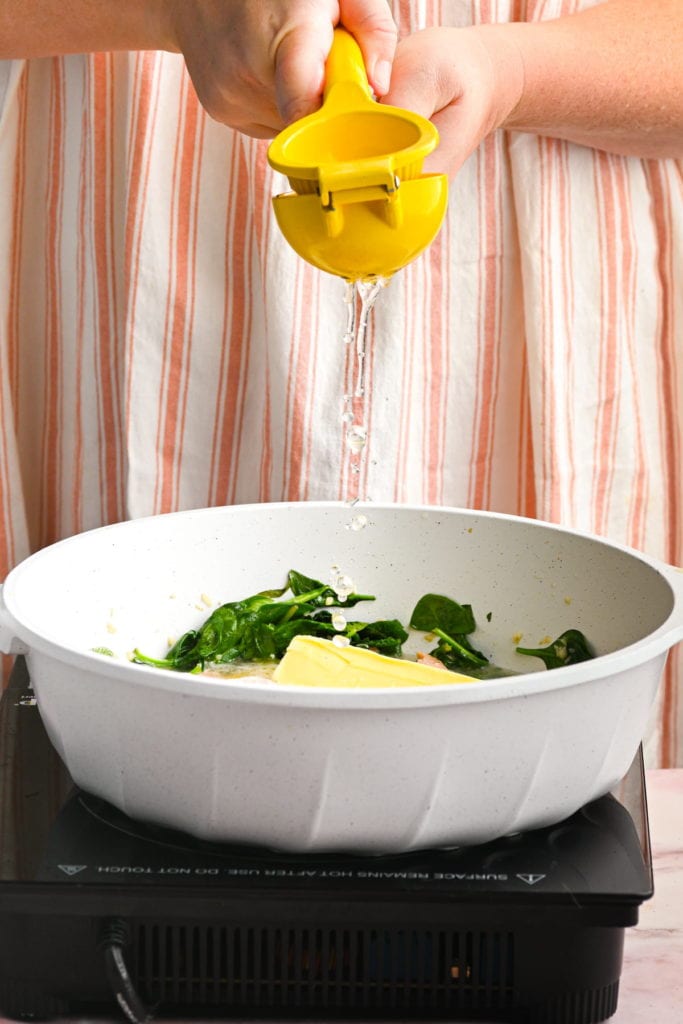
Add Your Pasta
Your pasta will be cooked in a separate pot according to the directions on the box.
Green tip: Don’t waste your pasta water, use it to water your plants! So long as it’s not salty, the starchy water helps fertilize plants and help them grow.
I used linguine in this Salmon Spinach Pasta (no cream) pictured, but you can use any long pasta. Some long pasta options that will taste great in this dish include fettuccine, spaghetti, angel hair, bucatini, tagliatelle, pappardelle, and vermicelli.

How to Properly Store and Reheat Spinach Salmon Pasta
This Salmon Spinach Pasta without cream will last for 3-4 days stored in an airtight container in the refrigerator.
The best way to reheat it is by adding your leftovers to a baking dish and preheating your oven to 375°F. Cover the baking dish completely with tin foil to trap moisture and heat the pasta and salmon in the oven for 20-25 minutes until heated thoroughly.
Similarly, you can freeze this Salmon Spinach Pasta for up to 3 months. Reheat the same way as described above, but for an additional ten minutes (30-35 minutes).
If you want a quicker and easier reheating method, you can safely reheat leftovers in the microwave covered and on high for about 3 minutes. However, the microwave may dry out both the salmon and the white wine sauce. So, if you have the time, use the oven!
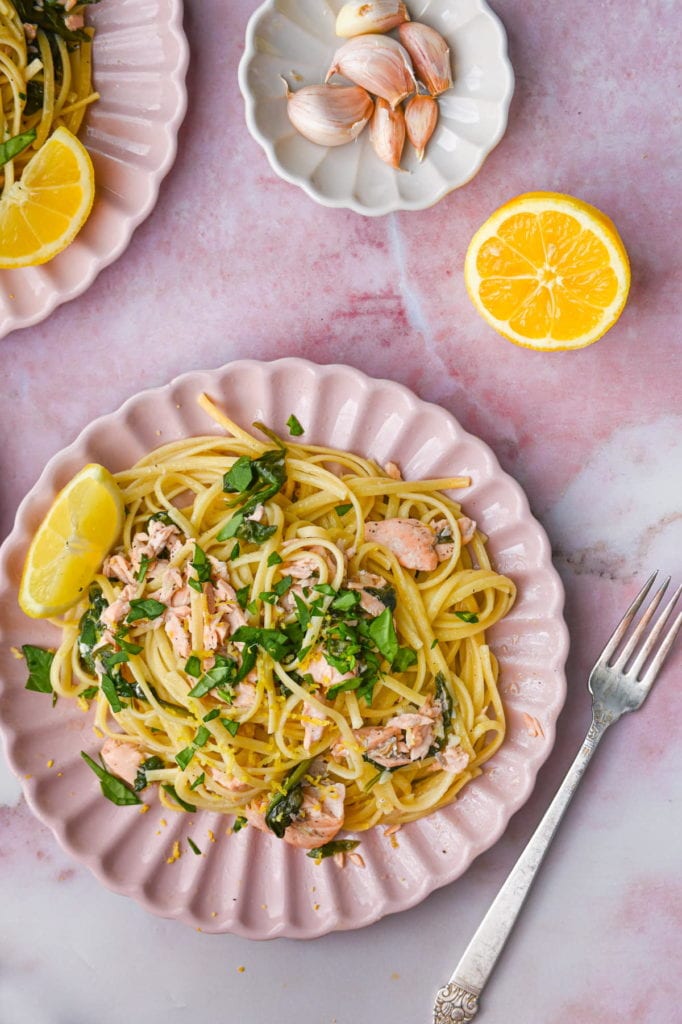
Salmon Spinach Pasta without Cream Frequently Asked Questions
What can I make with salmon and spinach?
If you have salmon and spinach to use, this Salmon Spinach Pasta with White Wine Sauce is perfect for you!
You’ll often see the winning combination of salmon and spinach in Mediterranean dishes, and this pasta is no exception.
Can you freeze salmon pasta?
Yes! Salmon Spinach Pasta with White Wine sauce can be frozen for up to 3 months. To reheat, add it to a baking dish and cover it completely with tin foil to trap moisture. Heat the pasta and salmon in the oven at 375°F for 30-35 minutes until heated thoroughly.
What do you eat with salmon?
Salmon is a great main course filled with healthy omega-3s and protein. It’s super flavorful on its own and is a great compliment to pasta, like in this Salmon Spinach Pasta or Cajun Salmon Pasta dish.
Otherwise, it’s tasty with a number of different delicious sides, including Saffron Rice, Roasted Asparagus, or even mashed potatoes!
Why You Should Make This Salmon Spinach Pasta
- It’s fresh. The fresh lemon and spinach give this pasta dish a vibrant flavor and color.
- It’s filling. Between the pasta and salmon, this recipe will yield generous portions of Salmon Spinach Pasta that will fill you up and keep you satisfied.
- It’s nutritious. Between the salmon and spinach, this yummy dinner is packed with protein and nutrients.
If you’re loving this Salmon Spinach Pasta and want more seafood mains, check out this Creamy Smoked Salmon Pasta and Blackened Shrimp and Old Bay Mashed Potatoes.
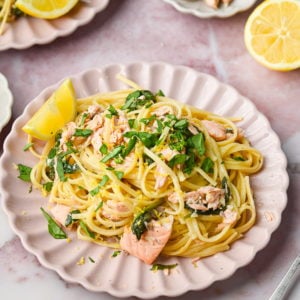
Salmon Spinach Pasta with White Wine Sauce
Equipment
- Bamboo Paper Towels (optional)
Ingredients
- 1 pound salmon (skinless)
- ½ teaspoon salt
- ½ teaspoon black pepper
- 1 large lemon, zest and juice
- 2 tablespoons olive oil
- 4 cloves garlic, minced
- 6 ounces baby spinach
- 1 cup white wine (Pinot Grigio or Sauvignon Blanc)
- 4 tablespoons unsalted butter
- 16 ounces long pasta (like linguine)
Instructions
- Bring a pot of water to a boil to cook your pasta according to the directions on the box to al dente. Prep your salmon by removing the skin if necessary and patting dry with paper towels (try these bamboo paper towels for a more sustainable option!).
- Season your salmon fillet on both sides with a pinch of salt and pepper and one squeeze of lemon juice.
- To a separate large saucepan or shallow pot, add the olive oil over medium heat and allow the oil to get hot for about 1 minute.
- Carefully add your prepped salmon to the hot oil, keeping your heat source at medium, and sear salmon for 2 minutes on both sides. Remove salmon from the oil and set it aside (it’s okay if your salmon isn’t cooked all the way through at this point).
- Add the minced garlic to the hot oil and cook for another two minutes until fragrant. Then, add your spinach and cook for another 2-3 minutes, tossing occasionally until most of the liquid has released from the spinach.
- Use a fork or knife to break the seared salmon into bite-sized pieces and add it back to the saucepan with the garlic and spinach.
- Add the white wine, butter, lemon zest, lemon juice, and remaining salt and pepper to the saucepan and bring the heat down to low. Simmer, uncovered, over low heat until the butter is melted and the salmon is cooked thoroughly.
- Add your cooked pasta to the sauce and toss until coated.
- Serve hot. Option to garnish with a little extra lemon zest and a crack of fresh black pepper. Enjoy!
Pro Tips
- Pinot Grigio and Sauvignon Blanc are the preferred wine varieties for this dish, but any dry white wine will do. Just avoid super sweet wines like Moscato or Riesling.
- If you like salmon, you’ll love this collection of my best salmon recipes!
Share This Recipe
